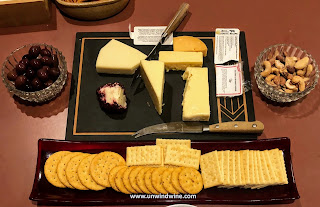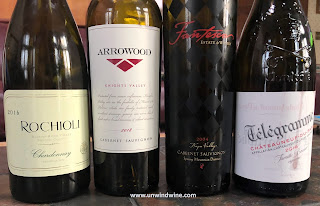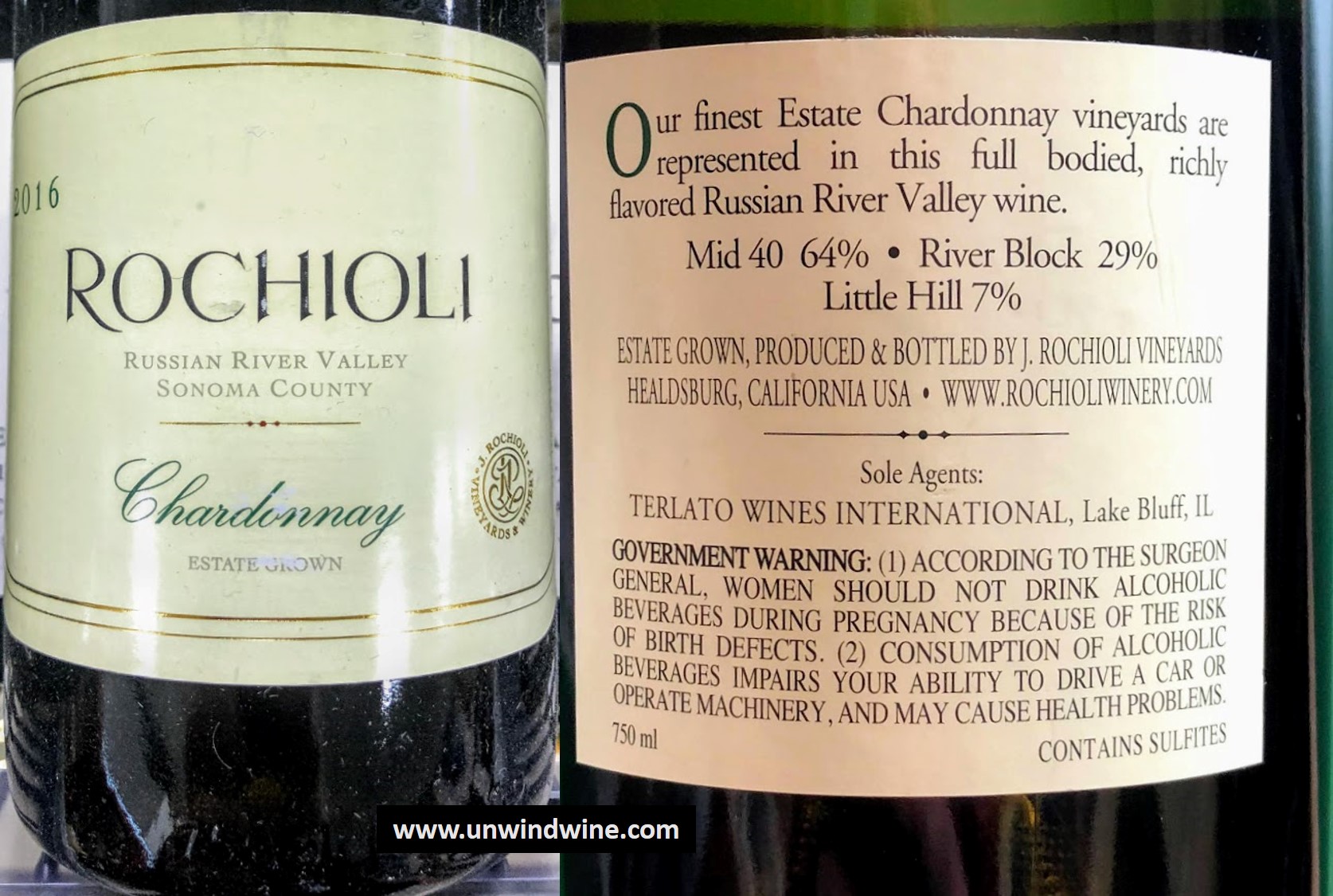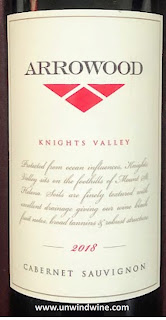Wine Dinner Features Spring Mountain Wines
We invited colleague Tom C and
wife Lisa for an intimate wine dinner. Tom recently won his Sommelier Certificate, so we were eager to get together and share insights and perspectives over some fine wines. Linda prepared beef tenderloin,
whipped potatoes and haricot verts. Prior to dinner we served a
selection of artisan cheeses, 14 year aged Cheddar, Stilton Blue,
Havarti and a Bellavitano.
We toured our wine cellar
and discussed appropriate wines for the evening and landed on Spring
Mountain District Napa Cabernets. Tom and Lisa visited there and stayed
at the fabulous Spring Mountain Winery Chateau, site of the former
Falconcrest TV Series, so the area had special memorable significance for them.
Of
course we love Spring Mountain District wines, and have enjoyed visiting and touring
there on many of our Napa Wine Experiences over the years
visiting Pride, Fantesca, Keenan and others. We have a respectable collection from which to
choose. Indeed, this follows on a Keenan Winery Napa Valley Spring Mountain
Cabernet that we enjoyed just the other evening, featured in my most recent blogpost in these pages.
After some deliberation we pulled from
the cellar for tonight's dinner three selections: Paloma Merlot 2003,
Robert Craig Spring Mountain District Cabernet Sauvignon 2007, and a
Fantesca La Petite Soeur Red Bordeaux Blend 2007, which also provided a mini-horizontal comparison tasting of that vintage.
Tom and Lisa brought dessert and a Chateau Rieussec Sauterne. We also opened a Kracher TBA - Trockenberrenauslese for a comparison tasting.
I
paired the Paloma Merlot with Fantesca Cabernet back in an earlier
Spring Mountain tasting in 2013 which I posted in these pages.
Paloma Napa Valley Spring Mountain District Merlot 2003
We started with this special 2003 release Paloma Merlot that followed the 2001 release that
gained notoriety when the 2001 Paloma Merlot was awarded 95 points and named Wine
Spectator's #1 “Wine of the Year” in
2003, out of over 15,000 wines evaluated.
I reiterate my post about Paloma from last year here.
Paloma is Spanish for “dove”, the estate sits on a steep, tree-lined ridge at the
very top of Spring Mountain in the Mayacamas Mountain range that forms the west wall of Napa Valley, sitting between Bald Mountain to the
south and Diamond Mountain to the north.
Founded
by Barbara and Jim Richards in 1983, seeking a vineyard to highlight
the grapes and terroir of their favorite region, they were turned on to
the property by winemaker producer friend Dan Duckhorn. Over the next 25
years, Jim and
Barbara worked to clear, plant, and cultivate 7,500 Merlot, Syrah,
and Cabernet Sauvignon vines.
The Richardses were transplants from Midland, Texas, where Jim
worked as a petroleum geologist -- got the wine bug in the 1980s. He
bought the property at the top of Spring Mountain Road in 1983. They
planted it in 1985, choosing Merlot because they had tried Dan
Duckhorn's Merlot and found it to their liking. Duckhorn, a Napa Valley
Merlot pioneer, encouraged them to plant, and even bought their grapes in those early years.
Spring Mountain is a cool spot and its grapes are often harvested
late in the season. It's typically cooler in the day and warmer at
night there than on the valley floor, and those factors come into play
in the even-ripening that Paloma's grapes enjoy. Yet after the first few
crops, which produced precious little fruit, the Richardses were
concerned that they may have made the wrong decision. "I figured maybe
Merlot won't do well at this elevation," recalls Jim, now 72, who speaks
with a soft, west Texas accent.
But then, as the vines matured and Barbara cruised through the
15-acre vineyard on her ATV, quality picked up. The wine has earned
outstanding marks in five vintages, and the debut 1994 is still awesome,
says Foley. By 2000, the Richardses were ready to fly solo. Foley had
helped them design a small winery and, Jim says, "I still ask everyone
as many questions as I can" to find out how to improve on grape growing
and winemaking techniques. The Richardses' son, Sheldon, joined
the winery during this time and began learning the ropes.
Paloma was a vineyard back in the last half of the 19th century but was returned to forest around the turn of the
century. There still remain old redwood grape stakes and a few old
zinfandel vines that survive under amongst the large Douglas fir trees that
surround the estate home. One historic vine near the house produces one or two clusters
of grapes a year that are put into our Merlot blend for good luck.
In 1991, some of the grapes were sold to Pride to be
blended into their Cabernet Sauvignon. Jim worked and
learned enology alongside legendary winemaker, Pride’s very own, Bob
Foley. In 1996, Paloma released their first-ever vintage, the 1994
Merlot - 575 cases total. Paloma’s first commercial Syrah was released
in 1998.
Paloma built the
estate winery in 2000 where they crushed their own fruit that year for the very first time.
Their son, Sheldon, joined the business in August of 2003, just in
time for harvest and for the release of the award-winning 2001 Paloma
Merlot. The follow-on
2002 and 2006 vintages were also recognized as the Wine Spectator’s Top 100 at 54
and 65, respectively.
The 2001 Cabernet Sauvignon and the 2009 Cabernet Sauvignon
(Sheldon’s first solo vintage as winemaker), received high praise from James Laube of
Wine Spectator in two separate articles written in 2007 and 2009.
Jim and Barbara passed on in 2009 and 2016, but their legacy lives on
under the stewardship of son Sheldon as owner and winemaker.
Paloma
reflects the
terroir and specific micro-climates of the area and the high altitude
Spring Mountain property. The topography of the area has its own
weather patterns being among the the coolest, wettest place in the Napa
Valley. High above the Napa Valley and the morning fog, Paloma Vineyard
is
generally 15 to 20-degrees cooler on hot summer days than the valley
floor vineyards. The more moderate temperatures and the volcanic soils
are what make Paloma wines so special, adding layers of complexity to
the mid-palate and long finishes.
Springs appear throughout the area after a good rain, hence the area’s name. The
combination of the summer heat and low pressure from the cool coastal
air that approaches the summit from the west lengthens the growing season into late fall. The prolonged hang time
– several weeks longer than warmer Napa Valley floor – add resonance
and concentration to the resulting small clusters.
The vines are planted on mostly steep,
east-facing hillsides. The Sonoma
volcanics and Franciscan sandstone soils stress the grapes, forcing them to stay small, with a
higher skin-to-grape ratio. The resulting mountain wines tend to be more
concentrated and intense, softened by the gradual
temperature fluctuations. The wines from the site are bright and
bold but with a surprising softness and elegance.
Paloma Napa Valley Spring Mountain Merlot 2003
We
love Napa Valley mountain fruit wines with their richness, focus and
concentration, and Spring Mountain wines are amongst our favorites.
We're long time fans and collectors of Pride Mountain, Fantesca and
Robert Craig Spring Mountain Cabernets.
We still hold several
vintages of this label dating back to 1999 and our patience is rewarded
tonight enjoying this aged nineteen year old.
Paloma Merlot is a blend of estate grown Merlot and Cabernet
Sauvignon. The Cabernet Sauvignon ranges from 14 to 16 percent depending
on the vintage.
Winemaker notes: The wine is a big, world-class red capable of
improving with bottle aging for at least 20 years in most vintages.
Although the characteristics of the wine vary with each vintage, they
have a consistent thread of complex aromas of blackberry fruits, black
stone fruits, chocolate, tobacco, spice, and floral notes with a mineral
overtone. On the palate, the wine has a silky mouthfeel, is well
balanced with flavors of berries, fruit, cocoa, cassis, and spice, and
enjoys a long spicy finish. The addition of the Cabernet Sauvignon adds
structure, rich fruit, and a subtle increase in tannins."
This release was awarded 90 points
by
Wine Spectator and 89 points by Robert Parker's Wine Advocate.
I
first wrote about this wine in September 2013 when I gave this 93
points and wrote that I like this wine: "At ten years old this may be at
or approaching its apex as it is
drinking better than any of the previous half dozen bottles we've tasted
from our case. I was worried at first when decanted as the color seem a
bit dark with a slight brown hue but the aromas were pure berry. Medium
bodied, silky smooth, elegant and polished with complex layers of
raspberry, sweet current, blue and black berry highlights. This tasting
was consistent with my last posted tasting notes from a year ago this
week (September 2012) when I wrote, "Medium full bodied, smooth
polished, complex
harmonious symphony of finely integrated aromas and flavors -
predominant sweet black currant, red raspberry, milk chocolate, a hint
of ripe plum, sweet oak and a bit of burnt sugar caramel on the long
smooth polished finish." Based on this tasting, I extended my drinking
window in Cellartracker which was listed as drink by 2011 to 2016.
At
nineteen years, the fill level was
perfect, as was, importantly, the cork, reflecting the ideal conditions
of our cellar
for long term aging. Of course, as show, Paloma bottles are painted
rather than having glued paper labels. Like I did back in 2013, tonight I
once again extended the drinking window for this wine, to 2022, as it
is still showing well, holding its own, likely at the peak of its
drinking window, perhaps nearing the end such that it might now start to
diminish from further again.
This
was dark inky purple garnet colored, medium-full bodied, with intense firm
concentrated structured rich black currant and blackberry fruits with
notes of cedar and nutmeg, black tea, dark mocha and cigar box with firm focused
tannins on the gritty lingering finish.
RM 92 points.
https://www.cellartracker.com/wine.asp?iWine=109466
https://palomavineyard.com/
https://twitter.com/palomavineyards
We tasted this label on posted tasting notes in Cellartracker back in 2012 and 2013.
https://unwindwine.blogspot.com/2022/09/paloma-napa-merlot-2003.html
https://unwindwine.blogspot.com/2013/09/spring-mtn-classics-fantesca-cab-and.html
Robert Craig Napa Valley Spring Mountain District Cabernet Sauvignon 2007
This Robert Craig Spring
Mountain label was first released in 2005. It was sourced from the picturesque Joan Crowley
vineyard perched at 2000 foot elevation along the summit of Spring
Mountain, high above the town of St Helena in the Mayacamas Range that
forms the western slope of Napa Valley. The site is primarily
dry-farmed, reducing vigor and crop yield resulting in small,
flavor-packed berries.
As I have written often in these pages,
Robert Craig focused on and specialized in hillside and mountain fruit from
leading producing regions of Napa including Mt.
Veeder, Howell Mountain, Spring Mountain and Diamond Mountain. Add Mt
George and Atlas Peak above the town of Napa and you have the four
corners of the Napa Valley. He often referred to it as 'four mountains
and a valley' in describing his portfolio of Cabernets.
We hold a vertical collection of Robert Craig Cabernets going all the way back to their inaugural vintage release in 1993. It is one of the largest producer collections in our cellar across seven different labels and three decades of vintages.
While
Robert Craig Winery owned many of their vineyard sources, they
bought fruit from select vineyards on the various mountains. They worked
with Napa Valley based
hillside vineyards generally at altitudes of 1,600 feet or higher.
Robert started
his career up on Mt Veeder, initially developing the William Hill
vineyard, and then later, at
The Hess Collection as their General Manager. In addition, he helped
develop 300 vineyard acres on Mt. Veeder for the movie star comedian
Robin Williams estate. Robert Craig sourced Cabernet Sauvignon fruit
from there for over two decades for the Mt Veeder designated Cabernet
label until Robin's passing and the recent sale of the estate and the
Pym Rae vineyard to the French Tesseron wine empire Family. Their recent
first release label from that property was priced at $350. Robert often
said that Mt Veeder was his favorite of his Cabernets. He was
instrumental in forming
sub appellations for both Mt. Veeder area and Spring Mountain.
We memorialize Robert who passed away a year ago in September 2019 from complications from Parkinson’s disease in this blogpost - Robert Craig Tribute.
The Robert Craig Winery is perched at an elevation of
almost 2300 feet high up on Howell Mountain on the north east side of
Napa Valley. It is among some of Napa’s highest vineyards. At this elevation they actually see some snow in
the winter at times. The location sits above the town of Angwin and their permit at the
actual winery limits them to an extremely small number of visitors, as
well as only several events per year at the actual winery, hence, they
maintain a tasting room in the city of Napa.
We attended a several tastings and dinners over the years with Robert and Lynn Craig and sometimes staff when various events.
Some
of the highlight over the years were a private dinner with Robert and
Lynn at the CIA back in 1988, another was a private tasting there at the
Robert Craig Howell Mountain Estate in 2008, where we also attended the Harvest Party at the estate in 2009.
http://www.mcnees.org/winesite/napa/napa-09/napa-09-craig/napa_harvest_09_craig.htm
http://www.mcnees.org/winesite/napa/napa_08/napa_08_craig.htm
My
recollection is that I first tasted this Spring Mountain label upon its
release during that visit in 2008. It was a comparison tasting against
the Mt Veeder and Howell Mountain labels, the Spring Mountain was served
from the barrel, and it was my standout favorite, being slightly
sweeter than the other two. I remember the allocation for Club members
was limited to three bottles. I negotiated a mixed case purchase of
twelve bottles of the 05, 06 and 07 vintages, the remains of which we're enjoying tonight.
Robert Craig writes of this label; "The
Crowley vineyard is a close fit for our mountain Cabernet portfolio
from the highest elevations of Napa Valley. Overlooking St. Helena from
its perch at 2,000 feet, this vineyard’s rocky volcanic soil, varied
hillside exposures, and moderate climate produce densely concentrated
winegrapes. Joan Crowley’s low-yield, biodynamically farmed vineyard has
provided us with deep, aromatic and structured wines since our first
vintage with it in 2005. The mountain is cooled by afternoon breezes
from the nearby Pacific Ocean, creating moderate daytime temperatures
and cooler nights that allow grapes to ripen slowly without pushing high
alcohol and sugars. The heady, deep perfume that is a Spring Mountain
District signature is always present in this cabernet that is hard to
come by."
In addition to Cabernet Sauvignon varietal grapes, Robert
Craig also sourced from the Crowley vineyard Bordeaux varietal Petite
Verdot.
Robert Craig Napa Valley Spring Mountain District Crowley Vineyard Cabernet Sauvignon 2007
This
release was awarded 94 points by Robert Parker's Wine Advocate, 92
points by Wine Enthusiast and Wine Spectator, and 17.5/20 by Jancis
Robinson.
Parker wrote, "This is a very exciting
wine that should drink well for 20-25 years." (RP) 94+
(12/2009)
Production of the 2007 release was a mere 640 cases.
Winemaker notes on Spring Mountain and the Crowley vineyard. The Crowley vineyard is a close fit
for our mountain Cabernet portfolio from the highest elevations of Napa
Valley. Overlooking St. Helena from its perch at 2,000 feet, this
vineyard’s rocky volcanic soil, varied hillside exposures, and moderate
climate produce densely concentrated wine grapes. The mountain is cooled
by afternoon breezes from the nearby Pacific Ocean, creating moderate
daytime temperatures and cooler nights that allow grapes to ripen slowly
without pushing high alcohol and sugars.
for a sense of place that establishes a wine’s
unique identity, is the perfect concept to describe the qualities of
Spring Mountain District Cabernet Sauvignons.
Dark garnet purple colored, full-bodied, complex, dense concentrated full
and round blackberry, wild berry and plum fruits with notes of spice,
smoked meat and cassis with a lingering smooth polished finish.
RM 93 points.
In 2009 Robert Parker wrote that this is a very exciting
wine that should drink well for 20-25 years. Wine Enthusiast said this this
is a good
wine to seek out for the cellar. The producer comments on the 2019
vintage release of this label - "That is to say, it is one of the
highest
quality red wines to be produced anywhere in the Napa Valley at any
price."
https://robertcraigwine.com/
https://twitter.com/RobertCraigWine
@RobertCraigWine
https://unwindwine.blogspot.com/2019/09/robert-craig-tribute.html
Fantesca La Petite Soeur Red Bordeaux Blend 2007
Fantesca Estate and Winery
is
one of our favorite Napa Valley producers. We hold a vertical collection of more than a dozen and half vintages of their estate Cabernet Sauvignon. Fantesca was conceived and founded by Duane and Susan
Hoff, who moved on from their careers as executives at Best Buy Corporation to Napa
Valley winery and vineyard proprietors when they acquired this
historic Spring Mountain District estate. The vineyards, winery and home sit above St Helena on the lower reaches of Spring Mountain in the Mayacamas Range
between Mt Veeder and Diamond Mountain.
We visited their spectacular mountainside estate during our Napa Wine Experiences in 2007 and in 2009.
We hosted Duane here at our home during his initial release promotional tour visit to Chicago back in 2004.
 |
Duane Hoff pouring 2002 vintage while visiting Rick & Linda
in Chicago during 2004 vintage release marketing outreach. |
Their's is a story book tale that started when Minneapolis natives, Susan and Duane Hoff were college sweethearts and entrepreneurs at heart, who both had meteoric careers at Best Buy Corporation, from the earliest startup days to corporate leadership roles. They left Best Buy and moved their family to Napa Valley in 2004 upon acquiring and founding Fantesca Estate and Winery. Today, Susan and Duane enjoy growing a business with their adult children – one of whom is an aspiring winemaker, and the other, a budding biotech entrepreneur.
 |
Fantesca Spring Mountain District
Vineyards |
Initial the early year 2002-2007 vintages from the estate were managed by winemakers Nils and Kirk Venge; then in 2008 they teamed up with legendary winemaker Heidi Barrett. The celebrated winemaker has been referred to as “The Wine Diva of Napa” and as “The First Lady of Wine.” She gained fame and recognition producing exceptional high quality wines that she produced for famous labels.
In addition to Fantesca, her current portfolio includes Amuse Bouche, Paradigm, Lamborn, Kenzo Estate, Au Sommet, Vin Perdu and her own labels, La Sirena and Barrett & Barrett. She has worked previously with Screaming Eagle, Dalla Valle, Jones Family, Grace Family, Vineyard 29, David Arthur, Barbour Vineyards and Showket.
Heidi grew up in a winemaking family in the Napa Valley and attended UC Davis, where she received a B.S. in fermentation science. After several harvests in Napa Valley and abroad, Heidi became the winemaker at Buehler Vineyards at age 25. It was at Buehler that she began attracting recognition by greatly improving the wines. After five years with Buehler, she moved on as an independent winemaker — and was quickly hired by Gustav Dalla Valle of Dalla Valle Vineyards.
Heidi made her mark at Dalla Valle creating powerful yet elegant Cabernets, including the cult wine “Maya,” a Cabernet blend awarded 100 points by Robert Parker for the 1992 and 1993 vintages.
In 1992 Heidi began crafting wine for Screaming Eagle and again received two perfect 100-point scores, for the 1992 and 1997 vintages. At the Napa Valley Wine Auction of 2000, a 6-liter bottle of Heidi’s 1992 Screaming Eagle Cabernet set a world record for the highest price ever paid for a single bottle of wine at $500,000. The following year, a vertical offering of this cult wine went for $650,000.
From their initial ten acre vineyard, they produced ultra-premium 100% Cabernet Sauvignon, and there is an acre planted in Petit Verdot. They also sourced grapes from the Sonoma County Russian River Valley to produce a bright crisp full flavored Burgundian Chardonnay, the first ever by Heidi Barrett.
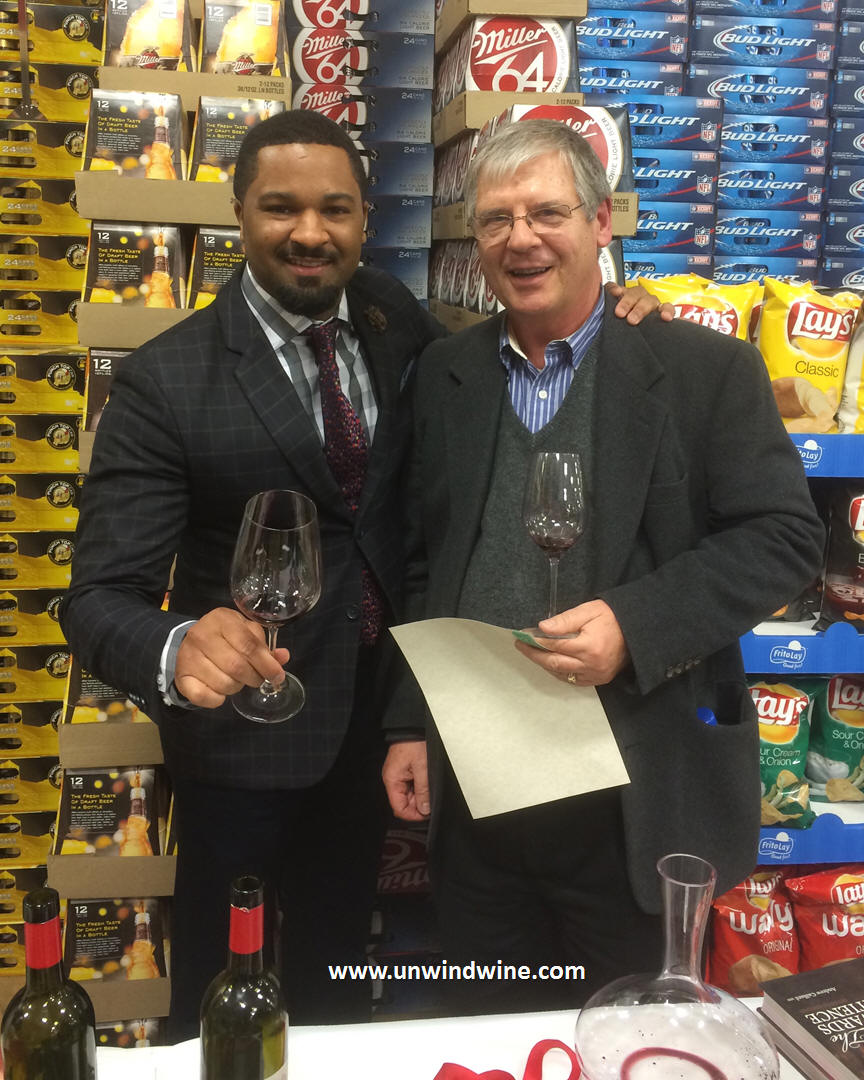
Recently, Fantesca have brought on Master Sommelier DLynn Proctor as wine ambassador and evangelist. I met DLynn when he hosted a Penfolds Tasting that featured Legendary Grange at our local Binny's back in 2014, when he was Penfold's Ambassador and Education Director for that icnonic Australian producer.
What fun to meet DLynn in person (right) having enjoyed watching his pursuit of his Master Sommelier Certification in the entertaining documentary movie SOMM which is a feature on Netflix. We saw DLynn on the Amazon Prime Somm III documentary the other night prominantly wearing this Fantesca jacket.
Fantesca products make for festive serving features or as elegant gifts as are lavishly packaged in stylish heavy etched glass bottles with painted 'labels', or in original wood cases.

In 2007 Fantesca released Le Petit Soeur, so named as Fantesca's 'little sister'. This Bordeaux Blend label is the unique small limited production blend that Heidi crafted for Fantesca initially to incorporate their their Cabernet and Petit Verdot for Fantesca family and friends. This 2007 release is a classic Bordeaux Blend of Cabernet Sauvignon, Merlot, Cabernet Franc, Petit Verdot and Petit Syrah of which 194 cases were produced. We acquired this label as part of our wine club allocation back in those early years.
I posted a tasting note of this label to Cellartracker back in 2010. At that time I gave it 91 points.
At fifteen years of age this has integrated nicely and evolved into an interesting sophisticated blend, probably at the apex or peak of its drinking profile and window, and not likely to improve any further with more aging, but likely to age gracefully for several more years.
Dark garnet and purple colored, medium to full bodied, nicely balanced blackberry and dark cherry fruits with notes of tobacco, black tea, spice, hint of clove and cedar with moderate smooth tannins on a tangy finish.
RM 91 points.
https://www.cellartracker.com/wine.asp?iWine=1045246
http://www.fantesca.com
https://twitter.com/FantescaWine
 This is a blend of mostly Cabernet Sauvignon, with Cabernet Franc, Merlot and Petit Verdot aged 22 months in French Oak.
This is a blend of mostly Cabernet Sauvignon, with Cabernet Franc, Merlot and Petit Verdot aged 22 months in French Oak. 




























